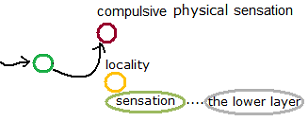The Kuriki method (the first edition in 2007) is a theory about Tourette’s syndrome (tic disorder) and obsessive-compulsive disorder to cure these diseases without medication. This theory is based on the author’s inference and interpretation regarding the structure of these diseases. Since it has been written for the psychoanalysts, reading will be difficult for people in general and it might be sometimes read erroneously. Therefore the Kuriki method must presuppose that the patient is treated by a nearby psychoanalyst, and that, between the patient and the Kuriki method, there is always the psychoanalyst. The explosion of emotional catharsis, which has strong repercussions, is done only for three seconds, once a week: beyond this rhythm, it would be an accident caused by negligence, and the psychoanalyst who is inexperienced in emotional catharsis must take responsibility for the temporary mental collapse caused by the accident. Also, to the patient who has weak capacity of logical reasoning, the psychoanalyst must explain well on the violent emotion of revenge caused by the illusory confusion between the person of the traumatic image in his head and the person in the real world.
Cure for Tourette’s syndrome (tic disorder) and OCD without medication
§27
2. Indefinite repressed sensations
In the next phase, tic will be a means of repression of disagreeable sensations in various parts of the body in various states. For example, foot pain, fatigue of the legs, back pain, the chair is too hard, a heavy luggage, cold wind, eating too much, during a simple sporting activity, etc. Also, disagreeable sensations of the whole body, such like having drunk too much, can be objects of repression, and « compulsive intramuscular sensation » of tic disorder will be used as a means of repression.
Theories, according to which the cause of a tic disorder can be a food allergy or a pollen allergy, etc., are not included in the Kuriki method. However, by appearances of tic, it is probable that tic disorder attempts to eliminate in the Conscious the sensation of a physical discomfort due to an allergy.
At the moment of doing something difficult that requires a mental concentration or at the moment of a mental tension, the « compulsive intramuscular sensation » of tic disorder reduce. The object of mental tension becomes the object of the Conscious and replaces the symptom of tic. The object of mental concentration will be a substitution of the « compulsive intramuscular sensation » of tic disorder. However the sensation of mental tension is also a set of bodily sensations, and « compulsive intramuscular sensation » of tic disorder can appear to repress these disagreeable bodily sensations; e.g., fear is a sensation of fear, which is a set of disagreeable bodily sensations due to an adrenaline secretion. It is also possible that the body posture is bad at the time of a mental tension, and the unconscious muscular tiredness can be a disagreeable bodily sensation.
These disagreeable bodily sensations are objects of the KV (bodily repression) by the « compulsive intramuscular sensation » of tic disorder. The « compulsive intramuscular sensation » of tic disorder is a hysterical reaction to these disagreeable bodily sensations. Since these disagreeable bodily sensations are not the cause of tic disorder, the elimination of these disagreeable bodily sensations will not be treatment of tic disorder. On the contrary, the awareness of the mechanism of KV is important in the treatment of the upper layer of tic. It is to reveal the KV. In addition, the awareness of disagreeable bodily sensations will bring about the discovery of the trauma.
Awareness of indefinite repressed bodily sensations
Indefinite repressed bodily sensations change all the time. Each time the patients need to do tic movements, they will search the disagreeable bodily sensation that tic is trying to repress. Each time, it is a different part of the body. For example, for a tic of the forehead muscle; “Now I have « compulsive intramuscular sensation » of tic disorder in the forehead muscle, because there is slight pain in the right hip.”, etc.
The repression of disagreeable bodily sensations by the « compulsive intramuscular sensation » of tic disorder functions automatically, so, even if disagreeable bodily sensations are still objects of the Conscious, the « compulsive intramuscular sensation » of tic disorder continues to appear. The word “repressed bodily sensations” does not mean the bodily sensations that have been effectively repressed. The words “repressed” indicates a passive object in the function of repression. Repressed bodily sensations can be very conscious and very obvious.

